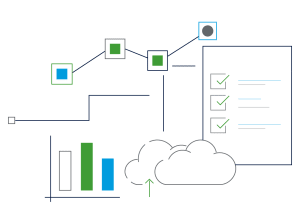This article answers the following questions:
- What is a statement of cash flows?
- Who is required to prepare a statement of cash flows?
- What are the methods for preparing a statement of cash flows?
Very often, individuals reviewing financial statements in search of information about a company’s condition focus primarily on analysing the balance sheet and the profit and loss account. In reality, however, it is the statement of cash flows that contains key information about the actual cash position and the direction of cash movements within an organisation – and it is this component of the financial statement that deserves particular attention when assessing a company’s situation. So what can be found in it, and how is it regulated by national and international accounting standards?
The nature and purpose of a company’s statement of cash flows
The statement of cash flows is a component of an entity’s financial statement. It provides information on the entity’s ability to generate cash and to utilise that cash in its operations – in other words, it shows the inflows and outflows of cash within the organisation’s core areas of activity: operating, investing and financing (in accordance with International Accounting Standard 7 and National Accounting Standard 1, in their current versions).
Cash flow is a highly important and fairly broad topic. Therefore, to explain it thoroughly, we will not only analyse the differences in the preparation of the statement of cash flows under the National Accounting Standard (NAS 1) and International Accounting Standard (IAS 7), but also discuss the impact of these differences on the interpretation of the entity’s final cash position.
Obligation to prepare financial statements including a statement of cash flows
According to the requirements of IAS 7, every entity applying International Financial Reporting Standards, regardless of its size, is obliged to prepare a statement of cash flows.
The standard recognises the cash flow statement as a mandatory and integral part of the financial statement as a whole (IAS 7, para. 1).
In contrast, Polish legal regulations, pursuant to the Accounting Act, exempt micro and small entities from the obligation to prepare and present a statement of cash flows. However, National Accounting Standard No. 1 indicates that if such entities choose to prepare a statement of cash flows despite the lack of a formal obligation, then – to maintain consistency and comparability of data – it is recommended that they apply the provisions of NAS 1 (NAS 1, para. 2.1).
Learn more about our services
What should be included in the cash flow statement?
IAS 7 provides only general guidance on the information that should be included in the statement of cash flows. Moreover, it does not impose a uniform format or rules for recognising individual items to be presented in the cash flow statement, thereby allowing entities a degree of flexibility in how they present the data in this component of financial statements.
The areas that should be presented in the cash flow statement are listed under “Presentation of the statement of cash flows” in IAS 7. These are:
- operating activities,
- investing activities,
- financing activities.
However, paragraph 11 of the standard further emphasises that an entity should present cash flows in a manner most appropriate to the nature of its operations. Paragraph 12, in turn, states that there may be transactions in the financial statement that must be separately classified within the respective sections of the cash flow statement (IAS 7, paras. 11-12).
NAS takes a much more detailed approach to recognising individual items in the statement of cash flows
Like IAS, NAS lists the areas that should be included in the statement of cash flows. However, NAS additionally – in Chapter 8 – provides detailed explanations regarding the disclosure of individual items and outlines the method for preparing the cash flow statement. In this section, entities operating in Poland will find specific guidelines on the items that the regulations recommend including in the statement of cash flows (NAS 1, Chapter 8). This is a significant simplification for accountants preparing financial statements, as such extensive instructions are not found in IAS 7.
Disclosure of income tax cash flows
IAS 7 states that companies must disclose income tax cash flows separately – within operating activities – “unless they can be specifically identified with financing and investing activities”. If this condition is met, then such cash flows should be presented in the appropriate sections of the cash flow statement (IAS 7, para. 35).
NAS 1, on the other hand, recommends a different approach – disclosing income tax cash flows in the notes and explanations to the cash flow statement (NAS 1, para. 8.11).
Indirect method – adjusting the financial result
Both national (NAS 1) and international (IAS 7) standards allow two methods for presenting the statement of cash flows – the indirect and direct methods. These differ only in the presentation of operating activities.
The direct method shows the main groups of cash inflows and outflows (NAS 1, paras. 4.8-9), while the indirect method adjusts the financial result for items that do not have cash effects. Helpful guidance for determining individual cash flow items is provided in NAS 1, paras. 8.4-8.5.
It is important to note that – in accordance with Appendix 1 to the Accounting Act – entities that choose to present the statement of cash flows using the direct method are required to disclose, in the notes, a reconciliation of cash flows from operating activities using the indirect method. This requirement ensures comparability and transparency of reports.
According to IAS 7, the indirect method involves adjusting the financial result (typically other than net profit, e.g. profit before tax separately from continuing and discontinued operations), whereas NAS 1 requires adjusting the net financial result. Additionally, IAS 7 encourages entities to use the direct method, arguing that it provides more useful information for forecasting future cash flows (IAS 7, para. 19).
Presentation of overdrafts and credit lines
NAS 1 recommends that entities present overdrafts and credit lines on a net basis – within financing activities in the cash flow statement (NAS 1, paras. 2.2 and 7.2). IAS 7, once again, allows greater flexibility and discretion in this matter.
The international standard states that changes in overdraft balances may be presented as part of operating activities and as “components of cash and cash equivalents” (IAS 7, paras. 7-9), provided that such credits form an integral part of the entity’s cash management. This approach may result in the cash balances reported in the balance sheet and the cash flow statement being negative.
Guidelines on interest from deposits and dividends
NAS 1 states that cash flows related to interest from deposits and dividends should be presented within investing activities (NAS 1, para. 6.3).
IAS 7, however, addresses interest and dividends separately (IAS 7, paras. 31-34). The international standard suggests that cash flows received and paid in respect of interest and dividends may be presented in investing, operating or financing activities. It is up to the entity preparing the cash flow statement to decide in which area to present the item, provided that the chosen classification is applied consistently in subsequent periods.
It is worth noting that for financial institutions, interest and dividends are generally presented within operating activities.
Consequences of the discussed differences in methods of preparing the statement of cash flows
The method chosen by an entity – whether under IAS 7 or NAS 1 – does not affect the final result of the cash flow statement, i.e. the entity’s cash position (except for the issue of presenting overdrafts under international regulations, which may result in a negative cash balance).
However, a challenge in interpreting the presented data is the fact that the information obtained by the entity and those reviewing the financial statement from the individual areas of cash flows is distorted by the above-mentioned differences between the standards. The way in which cash flows from investing, financing and – most importantly – operating activities are presented may be interpreted differently in statements prepared under IAS versus NAS. Therefore, it is crucial to understand these differences and to seek reliable sources of information on cash flow. Entities required to prepare and audit financial statements under IAS should primarily refer to the guidance provided in IAS 7. Meanwhile, companies preparing statements under the Accounting Act should apply NAS 1.
However, the Accounting Act stipulates that in matters not regulated by NAS, IAS may be applied (Article 10(3) of the Accounting Act).
If you have any questions regarding the statement of cash flows or need support in correctly interpreting the data contained in the financial statement, we encourage you to contact us directly. Our experts in financial audit, accounting and bookkeeping are well-versed in both global and local standards and have extensive experience in reviewing the documentation of Polish and international companies.







